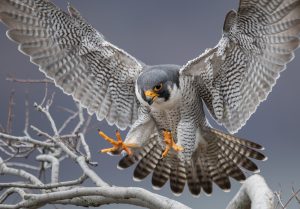
Does the story of the noble hero on a quest to find the feminine grail stir something inside you? If so, the hawk calls you. Does it cry “Beware!” or “Be aware”?
Are you drawn to the Egyptian falcon-headed god Horus and stories about the soul leaving the body when a person dies? If so, the falcon calls.
The falcon is the consummate hunter. Known for its speed and precision, it can catch its prey mid-air. The falcon teaches us how to make progress by blending speed and focus. The falcon also helps us send energy to a dying person, so the transition will be easy.
THE HAWK
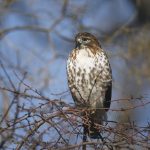
Hawk sitting in tree.
The hawk’s medicine is inward and deep. Where did you come from? Where are your roots? Who are your ancestors? The hawk wants you to see your life from a broad perspective.
The hawk wants you to let go of unnecessary baggage, the kind that is heaped on us when we’re children. Even the most well-meaning parents do it. Because they, too, are carrying baggage.
When the hawk comes into your life, the invitation isn’t to your family. It’s to you. The hawk wants you to recognize the significance of the events in your life — including past lives.
Did you give to someone, help someone, teach someone, inspire someone? Was that how you were treated?
Did you take from someone, ignore someone, criticize someone, cheat someone, hurt someone? Was that how you were treated?
It takes courage to look at ourselves, at our family stories, with the keen eyes of a hawk and fortify the honorable qualities and remove the vermin.
Working with hawk medicine awakens the vision we have inside us, the one about who we really are, what we really want to do with our lives.
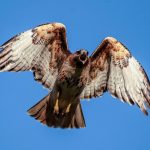 I’m reminded of the words of the late playwright Florida Scott Maxwell. She was born in 1883 and lived into her nineties. She said, “You need only claim the events of your life to make yourself yours. When you truly possess all you have been and done, which may take some time, you are fierce with reality.”
I’m reminded of the words of the late playwright Florida Scott Maxwell. She was born in 1883 and lived into her nineties. She said, “You need only claim the events of your life to make yourself yours. When you truly possess all you have been and done, which may take some time, you are fierce with reality.”
Fierce. That’s a good word to associate with hawk medicine. As parents, hawks practice tough love, or so it seems. Once their young can fly, the parents stop feeding them and send them on their way. Then again, maybe that’s not tough love. Maybe it’s the way hawk parents express confidence in their offspring.
Maybe a sense of confidence is what gives birds of prey their fearless quality. That fearlessness makes them the ideal companions for shamans who travel to the realm of the dead to obtain cures, to learn the wisdom of animals, to honor those animals, and make alliances.
In The Druid Animal Oracle authors Philip and Stephanie Carr-Gomm write about how Druid shamans would enlist the aid of a spirit-ally to venture into other realms. Different birds offered different gifts, different tools. The swan brought grace; the raven initiation. When it came to the hawk, the gifts were nobility and stature, dignity and pride.
We see those qualities in the legend of King Arthur. The Knights Gawain (the Hawk of May) and Galahad (the Hawk of Summer), each one a masculine solar figure, go in search of the feminine Holy Grail. On their quest for healing, completion, and illumination, each in his own way asks: Who am I? Why am I here?
We ask those same questions. Even as the hawk soars upward toward the sun, a metaphorical image of our quest, we know on some level that the answers we seek lie within.
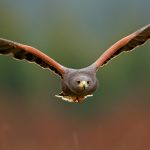 Just as hunters valued the hawk for its ability to see, circle, and hover over its prey, Druids valued the hawk for its ability to see what needed to be cleansed from a person’s spirit. It’s in that cleansing that we can claim who we are, and that we can become, as Florida Scott-Maxwell said, “fierce with reality.”
Just as hunters valued the hawk for its ability to see, circle, and hover over its prey, Druids valued the hawk for its ability to see what needed to be cleansed from a person’s spirit. It’s in that cleansing that we can claim who we are, and that we can become, as Florida Scott-Maxwell said, “fierce with reality.”
That kind of inward cleansing is something you must do by yourself. The relationship is one-on-one. Birds of prey don’t fly in flocks like geese or gather on the beach for a flash mob dance the way pink flamingos do.
In her book Bird Signs author G.G. Carbone writes, “If you have just met someone, take your time and get to know the person through observation. Hawks mate for life, so once you decide to commit to someone, the lifelong journey begins.” She suggests that to align with the energy of Hawk, take time to observe the little things in life.
My friend Carol Chaput is a fine artist who draws, among other things, owls and hawks. She’s also a poet with a passion for the natural world. Years ago, I asked if she could teach me to think like a poet. In response, she taught me to keep what she calls “the quarry.” Each day, she lists ten things she has observed. The hunt isn’t for pretty language, or even full sentences. The task is to train the eye to observe.
I kept my own quarry for several months, until I buried the book with the rest, residue, and remainder of so many other creative endeavors. I came across the book yesterday. Here are four items on my list for a day in January 2014:
- The ticking clock on the wall
- A picnic table and two benches, all one piece, a deterrent to thieves
- A discarded plastic dump truck
- An endless stream of error messages scolding from the monitor
At the time, I was too close to events to see a pattern. I wasn’t looking for one. Now, seven years later, I can see that when I made those observations I was still processing a professional loss I had suffered more than two years earlier.
Seeing a pattern was not the purpose of keeping a list. And yet, there it was — the emotional vermin I needed to remove. Seeing the pattern made it easy to break the pattern.
In these last seven years, I’ve acquired three of Carol’s original works. Two drawings are of solitary owls. One is of three baby hawks. How interesting, how encouraging, to think that the Owl and the Hawk have been with me all this time.
G.G. Carbone offers another lesson from the Hawk. Stop circling. Take action. In her words, “Maybe you have remained on the sidelines too long. With Hawk as your ally, you can experience life more actively.”
That idea of being an active participant in life is explored by the late Ted Andrews in his book, Animal-Speak. Focusing on the red-tailed hawk, Andrews draws a parallel between the red of the tail feathers and the kundalini, that spiritual energy coiled at the base of the spine, that, when aroused, moves up through the chakras, breaking through energy blocks, often at a time when a person is discovering her soul purpose.
 Andrews says that if the hawk has become your totem and your kundalini has been activated, “It can also reflect that your childhood visions are becoming empowered and fulfilled.”
Andrews says that if the hawk has become your totem and your kundalini has been activated, “It can also reflect that your childhood visions are becoming empowered and fulfilled.”
He talks about how hawks are often attacked by smaller birds and cautions that with the hawk as your totem, you are likely to be attacked by people who won’t understand your creative energy. “They may attack your ability to soar.”
Should that happen to you, know that the red-tailed hawk can bite off the head of a snake, even a poisonous snake. That’s because the hawk’s legs have scales that protect it from snake bites. Of course, as Andrews points out, if the red-tailed hawk has come into your life, you, too, have the ability to bite off someone’s head. Proceed with caution.
THE FALCON
Like eagles and owls, falcons are found all over the world. In her book Animal Magick, author D. J. Conway tells us that here in North America, what we call a duck hawk would be the peregrine falcon in old European falconry terms. In similar fashion, our pigeon hawk would be the merlin, and our sparrow hawk, the kestrel.
The word “falconry” refers to the practice of hunting with the use of a trained bird of prey. Records show falconry being practiced as early as 680 BCE in China.
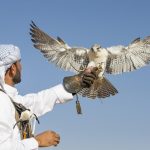 Training a falcon required a great deal of time and patience. A falcon would be taken from its nest as a baby then trained to be comfortable with humans.
Training a falcon required a great deal of time and patience. A falcon would be taken from its nest as a baby then trained to be comfortable with humans.
In the 9th century, falconry reached England. It became a popular sport of European upper class and a status symbol of sorts with the clergy. On the Richard III Society website, Shawn E. Carroll writes that the nuns of some religious orders were rarely seen without their falcons on their wrists. (I attended twelve years of Catholic school and was taught by two different orders of nuns. I can’t picture any of them sporting a falcon on her wrist. Times change.)
A trained falcon gave a significant advantage to hunters. In her book, The Shaman’s Guide to Power Animals, author Lori Morrison notes that in 14th century England, the punishment for destroying falcon eggs was a year in prison. A poacher who took a falcon from the wild could have his eyes plucked out as punishment.
Eventually, falconry became common. The local blacksmith might have a falcon. The baker, too. And the dressmaker, the shoemaker. In the same way today’s dog owners say something about themselves based on the size or breed of dogs they have, centuries ago men and women made statements about themselves based on size and type of falcon they carried. Ah, but not everyone was equal. The peregrine and the gyrfalcons, the “long-winged” birds, were reserved for the nobility.
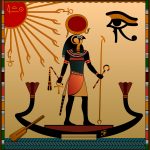
Falcon-headed Egyptian god Horus
The falcon played a key role in the mythology of ancient Egypt. That’s where we find the god Horus the Younger, son of Osiris and Isis. Horus is often shown as a man with the head of a falcon. Sometimes, he’s shown with two heads, representing the union of upper Egypt and lower Egypt.
The name Horus means “he who is above.” Horus was thought of as the protector of whoever was the current pharaoh. In fact, a pharaoh would be called “the living Horus.”
Horus had a jealous uncle whose name was Seth. (Think of Simba and Scar in The Lion King.) The two often fought. In one battle, Seth ripped out Horus’s left eye. Destroying someone’s eye would be horrific under any circumstances. For Horus, there was more to the story.
Horus’s eyes looked like the eyes of a falcon. Of far greater significance was that his right eye was the masculine, mathematical Sun; the left eye the feminine, intuitive Moon.
As the legend goes, it was when Seth ripped out Horus’s left eye, the Moon eye, that the phases of the moon began. Fortunately, the god Thoth (a version of the Roman god Mercury, the Greek god Hermes), was able to restore Horus’s eye. In the same way, a new moon is reborn every month.
Even today we see the famous Egyptian image known as “The Eye of Horus.” The symbol represents the right eye, the masculine, logical, math-minded eye. Healers of the day would use mathematical proportions in the Eye of Horus to determine how much of certain ingredients were needed to effect a cure, a prescription of sorts.
The Eye of Horus was also known as the Eye of Ra, the Sun God. Sailors would paint the symbol on their ships for the Sun God’s protection.
The mythology around Horus focuses on healing, protection, and restoration. Those qualities are all part of what we call falcon medicine.
Falcons are found in Greek mythology, too. That’s where we find the goddess Circe, a sorceress, daughter of the sun god Helios. When she was born, instead of having the expected soft, melodious voice, she sounded like a squawking bird. Her name, Circe, means hawk or she-falcon.
In Norse mythology, the goddess Freya wore a cape of falcon feathers. The cape made it possible for her to astral travel, to see beyond the limits of the physical world.
The whole idea of seeing beyond your limits is a key theme of falcon medicine as used in this safe and simple ritual:
RITUAL: The Big Picture
To begin, if you resonate with the energy of the falcon, be sure you rest in a place with a panoramic view. Yes, travel is still restricted because of the pandemic, but don’t let that stop you. Watch a nature show on television, a show that has a lot of panoramic views. Pause on an image you like. Embrace the vastness before you.
- Do you feel free, that you can do anything you want?
- Do you feel lifted, as though you’re in the air, the realm of thoughts and ideas?
- Do you feel focused, that you know what you really want?
- Do you feel brave, ready to face whatever stands in your way?
- Do you feel ready to take the plunge and go for what you want?
Feeling free, lifted, focused, brave, and ready — those are the gifts the falcon offers.
RITUAL: Tiger Eye
When you feel unfocused, flustered, like you need to defrag, get a piece of tiger eye. The stone is a mineral, a member of the quartz family. It’s relatively inexpensive and easy to find. In her book The Shaman’s Guide to Power Animals, author Lori Morrison, says tiger eye is the mineral associated with the falcon. With the eye being important to the magic and myth around the falcon, I understand the link.
Tiger eye is brown and gold. Think of the warm, golden sun, vitality itself, pouring onto the dark, fertile earth. The sun penetrates. The earth receives. Equilibrium. Hold that thought as you hold that stone. Feel it warm the palm of your hand.
Remember that ritual is a visible act performed with invisible intent. Close your fingers around the stone. That’s your visible action. Your invisible intent is to embrace the vitality and equilibrium from the stone, and in doing so, let yourself feel free, lifted, focused, brave, and ready.
Finally, if you know
- Someone who needs to see something clearly…
- Someone who is ready to let go of old baggage…
- Someone who has been on the sidelines of life too long…
Tell that person about the medicine of the hawk and falcon. She’ll thank you for it.
Zita Christian is a writer, ritualist, Life-Cycle Celebrant, and unabashed woo-woo woman. She hosts and produces Ritual Recipes, the podcast that helps spiritually-minded people create safe and simple rituals to give real meaning to seasonal cycles and life events. Write to her at: zita@ritualrecipes.net

